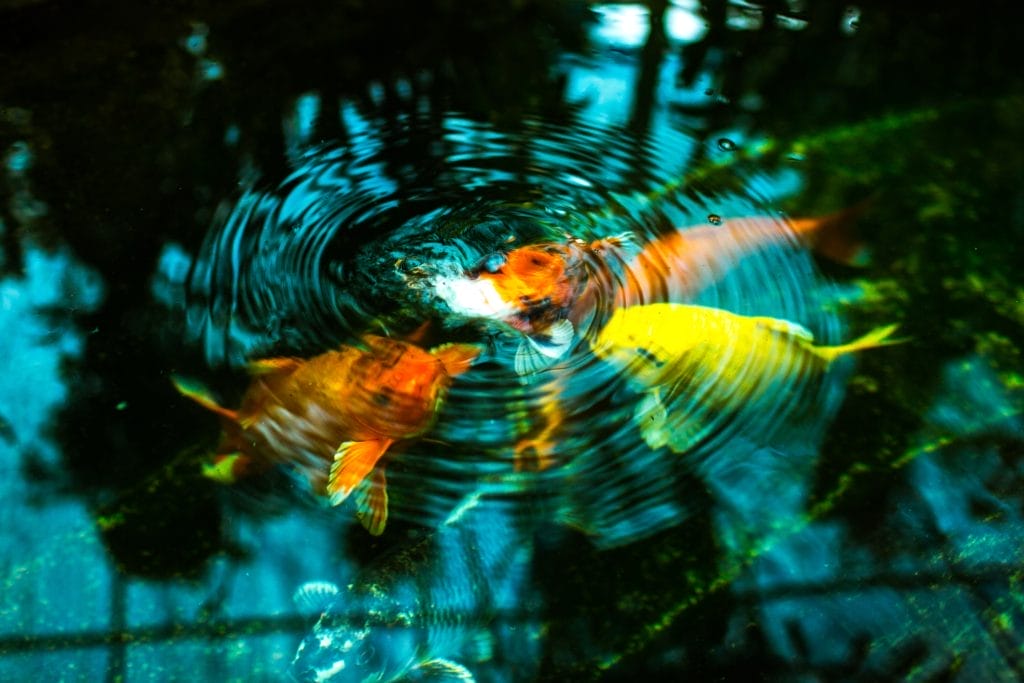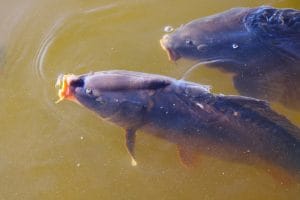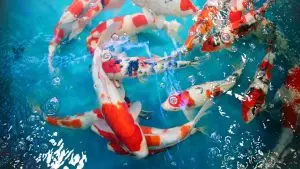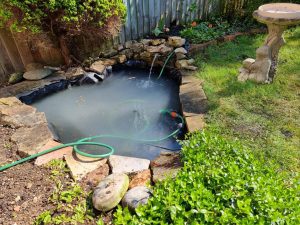
BEST Koi Fish Automatic Feeder: A Comprehensive Guide
Koi are beautiful and beloved fish that require specific care, especially when it comes to their diet.
A quality automatic feeder can simplify feeding routines while ensuring the koi receive the right amount of food at the right times.
The best koi fish automatic feeder not only helps maintain a healthy feeding schedule but also supports the overall well-being of the koi.

Choosing the right automatic feeder can enhance a pond’s environment. It allows koi enthusiasts to spend less time worrying about feeding and more time enjoying the beauty of their fish.
With features such as programmable timers and moisture-proof designs, these feeders are essential tools for any koi pond owner.
Key Takeaways
- A good automatic feeder promotes healthy feeding schedules for koi.
- Proper feeding helps maintain water quality and fish health.
- Selecting the right feeder can enhance the koi pond experience.
Understanding Koi Nutritional Needs

Koi fish require a balanced diet to maintain their health and promote growth. Their nutritional needs vary with the seasons, activity levels, and age.
A proper diet is key to their well-being.
Key Nutritional Components
Proteins: Essential for growth and muscle development. Koi typically need more protein during the warmer months.
Fats: Provide energy and support the immune system. Healthy fats help maintain energy levels.
Vitamins and Minerals: Vital for overall health. Vitamins A, D, and E play important roles in skin health and immune function.
Types of Koi Food
- Pellets: Commonly used for regular feeding. They come in various sizes and formulations.
- Sticks: These are easier for small koi fish to consume.
- Flakes: Ideal for surface feeding but may sink quickly.
Understanding koi food choices and their nutritional needs helps ensure koi receive adequate support for their immune systems and promote healthy fish growth.
Feeding koi correctly enhances their vibrant colours and supports their natural behaviours.
Automatic feeders can assist in providing consistent nutrition, ensuring koi receive the right amount at the right times.
The Importance of a Solid Feeding Schedule
A solid feeding schedule is crucial for the health and growth of koi fish.
Regular feeding helps establish a routine, which can lead to happier and more active fish.
Consistent feeding schedules prevent overfeeding. Overfeeding can harm koi by leading to excess waste and water quality issues.
A good routine ensures fish receive the right amount of food at the right time.
Key Benefits of a Feeding Schedule:
- Healthier Fish: A balanced diet promotes better health.
- Cleaner Pond: Less waste means cleaner water and a healthier ecosystem.
- Behavioural Benefits: Koi thrive on routines, making them more active and engaged.
Choosing the right feeding routine matters.
It is essential to consider factors such as water temperature, fish size, and the type of food used.
Adjusting the feeding schedule based on these factors is important for optimal health.
Tips for Creating a Successful Feeding Schedule:
- Feed at the same times each day.
- Observe their eating habits to adjust portion sizes.
- Reduce feeding during colder months when koi’s metabolism slows.
Benefits of Using an Automatic Koi Feeder
Using an automatic koi feeder offers several advantages for both the pond owner and the fish.
These devices ensure that koi are fed at regular intervals, promote better health, and reduce waste in the pond. Here are the key benefits in detail.
Precision in Feeding Schedules
Automatic koi feeders provide precise feeding schedules. This means that the user can set specific times for food to be dispensed.
Regular feeding at the same times each day helps koi develop a routine, which can reduce stress.
Many models can hold a substantial amount of food, allowing for multiple feedings each day.
With the right settings, these feeders can supply consistent portions, catering to the dietary needs of the koi.
Fish owners can also adjust feeding quantities to meet the demands of different koi sizes.
This detail is important for ensuring that each fish receives the right nutrition.
By maintaining precise schedules, automatic feeders help maintain a stable pond environment.
Prevention of Overfeeding and Waste
One significant benefit of using an automatic feeder is the prevention of overfeeding.
It helps to avoid the common mistake of inadvertently supplying too much food.
Overfeeding can lead to excess waste in the pond, which can harm water quality.
With an automatic koi feeder, users can easily control how much food is dispensed at each feeding.
This control minimises uneaten food, which can decay and pollute the water.
Having a set feeding limit also promotes healthier eating habits among the koi.
They learn to eat at designated times, which can help regulate their appetite.
This balance is vital for maintaining both fish and pond health.
Consistency for Optimal Fish Health
Consistency is key to optimal fish health, and automatic feeders provide just that.
Regular feeding schedules help to establish a routine, which koi thrive on.
When koi are fed consistently, they experience better growth and development.
Automatic feeders can handle varying amounts of food, making them suitable for different pond sizes and fish populations.
They can deliver the right amount of food every time, ensuring the koi receive nutrition without interruption.
This consistency also contributes to the pond’s ecosystem.
By reducing waste and maintaining stable feeding schedules, automatic feeders support a healthier environment for aquatic life in and around the pond.
Key Features of High-Quality Automatic Feeders

A good automatic koi feeder should have specific features that ensure effective and reliable feeding.
Sturdy construction, customisable dispensing options, and easy programming are vital for maintaining healthy koi. Here’s a closer look at these essential features.
Sturdy Build and Weatherproofing
High-quality automatic feeders are typically made from durable materials that withstand the elements.
Materials like rust-resistant metal or UV-protected plastics ensure longevity.
Weatherproofing is crucial, as it prevents water damage and protects the internal mechanisms.
Feeders with sealed compartments help keep the food dry, safeguarding its quality.
Regular maintenance is also a consideration. A sturdy build means fewer repairs and less frequent replacement.
This durability is essential for users who want to invest wisely in their koi care.
Customisable Dispensing Mechanisms
Customisable dispensing mechanisms are highly desirable in automatic feeders.
High-quality models often allow users to adjust the amount of food dispensed per feeding.
This feature ensures that koi receive the right nutrition without overfeeding, which can lead to water quality issues.
Some feeders offer multiple feeding times.
This flexibility lets users set schedules that align with their koi’s eating habits.
Easy adjustments can typically be made through simple controls.
Intuitive Programmable Timers
A reliable automatic feeder comes with intuitive programmable timers.
This feature allows users to set specific feeding times, ensuring consistency in the koi’s diet.
The best models usually have simple interfaces, making programming straightforward.
Look for feeders with options for different feeding schedules, such as daily or multiple times a day.
Some advanced models even include remote control and app connectivity for convenience.
This ease of use contributes significantly to the overall quality and functionality of the feeder, making it a vital feature for koi owners.
Selecting the Appropriate Feeder for Your Koi Pond

Choosing the right automatic feeder for a koi pond involves assessing several critical aspects.
Key factors include the feeder’s capacity, its power source, and ease of maintenance. These elements ensure that the pond ecosystem remains healthy and the koi receive optimal care.
Capacity and Portion Control
When selecting a koi fish feeder, capacity is vital. A feeder must hold enough food to meet the needs of koi, especially in medium and large ponds.
The Feed Mate P7000 pond fish feeder, for instance, is known for its impressive capacity, accommodating various pellet sizes.
Portion control is equally important.
The feeder should allow users to program feeding times and amounts to prevent overfeeding.
Consistent portioning helps maintain water quality and prevents uneaten food from polluting the pond.
Consider a model that lets one adjust the amount dispensed with ease to cater to the specific needs of their koi.
Power Source Options
Automatic feeders can be powered in several ways.
Options typically include battery-operated models, which offer flexibility in placement, and solar-powered devices, which are environmentally friendly. Both power sources have advantages.
Battery-powered feeders can operate without direct sunlight, making them reliable year-round.
On the other hand, solar-powered feeders reduce electricity costs and are perfect for sunny locations.
The choice will depend on the pond’s layout and the owner’s preferences, ensuring a continuous feeding schedule regardless of external conditions.
Ease of Maintenance and Cleaning
Maintenance is crucial for any feeder to work effectively over time.
A feeder should be designed for easy access to components for cleaning.
Regularly removing old food remnants and dirt ensures the health of the koi.
Look for feeders with removable hoppers and easy-to-wash surfaces.
Some feeders have features like weather-resistant materials, which make them suitable for outdoor environments, reducing wear and tear.
A feeder that is simpler to maintain will contribute significantly to the overall health of the pond ecosystem and its fish.
Exploring Different Types of Koi Food
Koi fish thrive on a varied diet. Choosing the right type of koi food can influence their growth, colour, and health.
Here are the common types of koi food available.
1. Floating Pellets
These pellets are designed to stay on the water’s surface. They are easy to monitor, allowing owners to see how much the fish are eating.
Floating pellets are often high in protein.
2. Sinking Pellets
Sinking pellets are best for koi that prefer to feed at the bottom of the pond. They can help reduce waste, as uneaten food does not float.
This type of food is also available in various sizes for different koi ages.
3. Flakes
Flakes are another option for feeding koi. They are suitable for smaller fish and can be easier for them to consume.
However, flakes may break apart quickly in water, leading to some waste.
4. Seasonal Varieties
Koi food can vary with the seasons. During warmer months, high-protein pellets support growth. In cooler temperatures, wheat germ pellets are beneficial as they are easier to digest.
Automatic Feeder Setup and Installation
Setting up an automatic koi fish feeder requires attention to detail. Proper configuration ensures that the feeder operates efficiently and consistently, helping maintain the health of the koi.
The following subsections will guide readers through the key steps.
Initial Configuration
To begin, the user needs to set the desired feeding schedule. Many feeders come with a programmable timer that allows for multiple feedings each day.
- Enter Feeding Times: The user should carefully enter the times for feeding, usually ranging from once to four times a day.
- Adjust Feed Amount: Depending on the model, users can adjust the dispensing mechanism to control the amount of food dispensed.
After initial setup, it is essential to test the feeder to ensure that it is working correctly. If the feeder includes a solar panel, make sure it receives adequate sunlight for optimal performance.
Choosing the Right Location
Finding the ideal spot for the feeder is crucial for its effectiveness. The location should be stable and easy to access for maintenance.
- Distance from Water Surface: The feeder should be positioned at a height where it can effectively distribute food across the pond surface. A distance of about 30 centimetres is often suitable.
- Sunlight Exposure: If equipped with a solar panel, ensure that the feeder gets sufficient sunlight throughout the day.
Avoid placing the feeder near areas of high debris to reduce clogging and ensure consistent feeding.
Safety and Security Measures
Safety is an important consideration when installing an automatic feeder.
- Secure the Feeder: Ensure that the feeder is firmly secured to prevent it from being tipped over by wind or other animals.
- Waterproofing: Verify that the feeder is designed for outdoor use and resistant to water damage.
Regular maintenance is also necessary to keep the feeder in good condition. Checking the dispensing mechanism and ensuring the solar panel is functioning will prolong the feeder’s life.
Maintaining Water Quality with Proper Feeding
Feeding koi fish correctly is essential for maintaining water quality in a pond. The right feeding routine contributes to a healthy pond ecosystem.
Overfeeding is a common mistake. When koi are given too much food, they cannot consume it all. This uneaten food breaks down and releases harmful nutrients into the water. As a result, it can lead to poor water quality and increased algae growth.
To avoid this, it is best to establish a consistent feeding routine. Automatic feeders can help by dispensing a precise amount of food at scheduled intervals. This ensures that koi receive their meals without excess.
Monitoring water quality frequently is vital. Key factors to check include:
- Ammonia levels: High levels can be toxic to fish.
- Nitrite levels: These should ideally be low.
- pH balance: Koi thrive in water with a pH of 7.0 to 8.0.
It is important to adjust feeding based on water temperature and koi activity. During cold months, fish require less food. Fish that are active and feeding properly contribute to a balanced pond ecosystem.
Review of Popular Automatic Koi Feeders
Automatic koi feeders offer convenience and ensure koi fish receive regular meals, even when the owner is not present. Two popular models are the Fish Mate P7000 and the EvoFeed Automatic. Each has unique features that cater to different pond sizes and feeding needs.
Fish Mate P7000 Pond Fish Feeder
The Fish Mate P7000 is a well-regarded automatic koi feeder known for its reliability and programmability. It has a large capacity of 7 litres, allowing for less frequent refilling.
The adjustable feeding times, up to four times a day, help maintain a consistent feeding schedule.
This feeder features a digital timer with an easy-to-read LCD display. Owners can set specific portions to avoid overfeeding.
Its robust design protects against weather elements, making it suitable for outdoor use. Many users appreciate the ease of installation.
Moreover, the Fish Mate P7000 is compatible with various types of koi pellets. This flexibility ensures users can choose the best food for their fish.
Overall, the Fish Mate P7000 offers a great blend of convenience and performance for koi pond owners.
EvoFeed Automatic
The EvoFeed Automatic is another option that stands out due to its innovative design. With a compact size, it is perfect for smaller ponds or those with limited space.
This feeder is also battery-operated, reducing the need for constant plugging in.
The EvoFeed allows users to customise the feeding times and portion sizes. A notable feature is the adjustable feed flow, which helps distribute food evenly across the pond.
This helps ensure that all koi have access to food without overcrowding at the feeding spot.
Additionally, its user-friendly interface makes setup straightforward. Customers often highlight its sturdy build, which withstands various weather conditions.
The EvoFeed Automatic effectively combines simplicity and functionality, making it a popular choice among pond owners.
Troubleshooting Common Issues
Using an automatic koi feeder can sometimes lead to issues. Here are some common problems and their solutions.
Overfeeding can be a frequent issue. If too much food is dispensed, it can harm koi health and pollute the water.
Adjust the feeder settings and check the amount of food provided.
Maintenance is essential to keep feeders functioning properly. Regularly clean the feeding mechanism to prevent clogs. This ensures proper food distribution and keeps fish healthy.
Digital timers often help feed on schedule. If it fails, check the batteries first.
Sometimes, timers may need resetting after a power outage. Make sure the current time is set correctly.
If the feeder does not dispense food, inspect the power supply and battery levels. Reduce food clumps that may block the dispensing mechanism.
Empty the feeder occasionally to check for jams.



